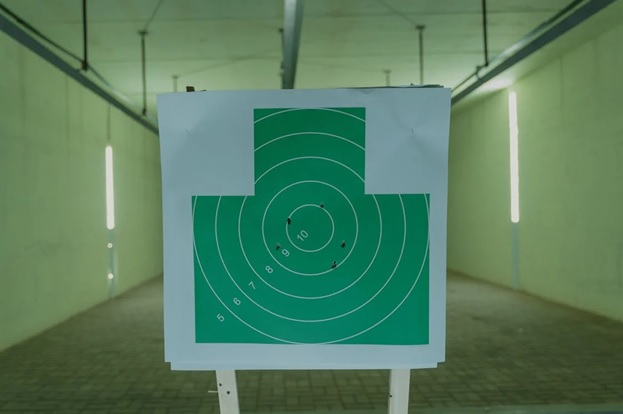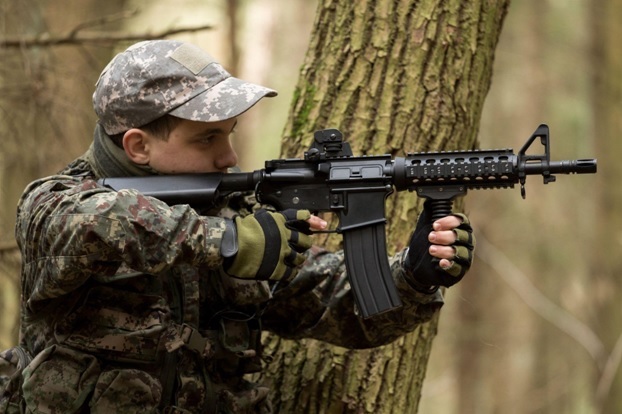In the civilian market, shorter AR barrels are increasingly popular, especially for those that love the military look and “tacticool” kick of carbine-length, M4-style modern sporting rifles.
It’s not just all hype, either. A shorter upper and thereby a shorter barrel are not without their virtues, and there are many of them. The shorter barrel results in a lighter rifle and one that is more maneuverable, too.
But a shorter barrel is not universally, unequivocally superior, by any stretch. In fact, by some metrics, shorter barrels are categorically, and indubitably, inferior.
So let’s take a look at the strongest case we can make for a 20-inch AR upper.
Longer Sight Radius
Arguably the biggest benefit of a 20-inch AR upper is that it produces a longer sight radius, which is the distance between the rear and front sights.
The longer the sight radius, the less serious the magnification of errors when the shooter does not line up the sights perfectly on a line between the two.
With a 20-inch AR upper, the sight radius is not just 4” longer, it is a whole 25% (that’s a full quarter) greater than the sight radius on a 16” barrel. That’s not nothing.
The result is that it is easier for a shooter to shoot a rifle with a longer barrel more accurately over open iron sights.
With that said, even if that were not the case, it remains the fact that it is easier to shoot a rifle with a longer barrel more accurately than one with a shorter barrel, especially at ranges beyond 100 yards.
Higher Muzzle Velocity
There is a big difference in muzzle velocity between a rifle with a 16” barrel and one with a 20” barrel, and we’re drawing this distinction with the expectation that the same exact ammunition is being used.
Consider two rifles shooting M855 ammo, that is, “green tip” 5.56. Let one be an M4 style carbine with a 14.5” or 16” barrel and the other an M16-style rifle with a 20” barrel. The 20” barrel can produce muzzle velocities of up to 200 FPS more than the shorter barrel.
That is a massive difference of nearly 10%, which really shows at extended ranges. It also means that the longer barrel categorically extracts more power from the same cartridge, making it better for hunting and defensive applications, notwithstanding the fact that the rifle may not handle as favorably in tight quarters.
Greater Accuracy at Longer Ranges
Alright, so there’s actually evidence that a longer barrel is not physically, or inherently, more accurate than shorter barrels, since shorter barrels tend to exhibit more consistent harmonics, and that, moreover, it’s harder for manufacturers to produce tight production tolerances through a longer bore.
But, given that, the stability and longer sight radius of a longer barrel tend to generate more accurate results. The higher muzzle velocity also means the rifle will produce a far flatter trajectory, which makes it easier and more effective to shoot at greater ranges.
This means that a rifle with a 20-inch AR upper will ultimately prove more effective for long-range shooting and hunting at extended ranges, all else being equal.

Less Stress on the Action; Longer BCG Service Life
The funny thing about the longer barrel is that it puts less stress on the gas system, bolt carrier group, and action in general. As a result, a longer barrel usually yields a greater lifespan from these components as a result.
The longer gas system of a 20-inch AR upper results in a greater drop in pressure before the gas gets to the gas key on the bolt carrier group. This results in a larger volume of gas operating at a lower pressure, exerting less force and heat on the rifle’s action.
Lower pressure at this point means that the bolt carrier group, the gas key, the bolt’s lugs, and the extractor are all subject to slightly less stresses than they would be in a carbine-length system.
Ultimately, this makes rifles with longer barrels more reliable and results in less routine wear, which generally means the action’s components will last longer.
Heavier Rifle, Less Felt Recoil
The M16 (and AR-15 rifles patterned after it) weighs more than a full pound more than an M4 and carbine-length ARs. Of course this will vary depending on the furniture with which you outfit the rifle, but as it stands, an M16-style rifle will weigh more than a pound more, which is more than a 10% increase in weight.
This means it is more fatiguing to carry the larger rifle, but it isn’t all bad news. That extra mass also helps absorb recoil, which means there’s much less felt recoil when shooting an AR with a 20-inch upper.
Actually, it’s not a huge difference and recoil is negligible in both sizes, but it does bear repeating that the heavier the rifle, the less felt recoil the shooter will experience.
The Tradeoff

Having said all of this, it’s important to point out that a longer barrel is not simply better. There is an asterisk here, or several, that in the spirit of fairness we must openly address.
One is that heavier rifles are harder to carry. This makes them less amenable for some defensive applications and depending on the discipline, less suitable for hunting, too.
A rifle with a longer barrel will also be far less maneuverable than one with a shorter barrel, which makes it inherently less effective in cramped spaces.
Other than that, you have to take the good with the bad, whether you ultimately decide to build a rifle with a shorter barrel or a longer one. It all comes down to what you intend for the purpose of the rifle to be.
Starting with a 20-Inch AR Upper
Convinced yet that a 20-inch AR upper will yield the best build for your intents and purposes? Start with an assembled upper from MCS Gearup and get the lower parts you need to complete the rifle here. Call us if you have any questions before beginning your project and we would be more than happy to help.

